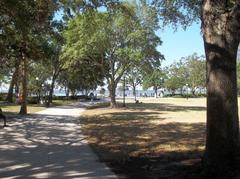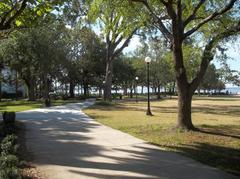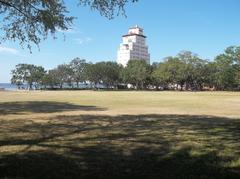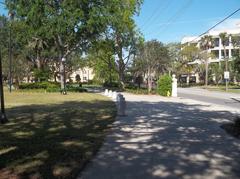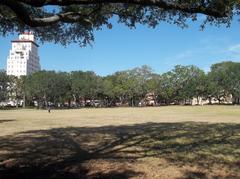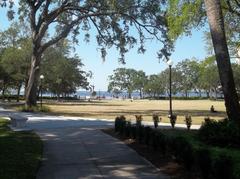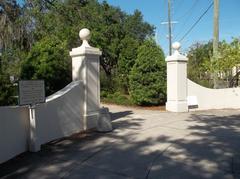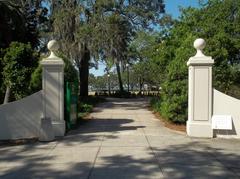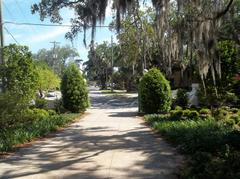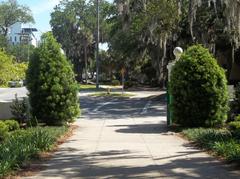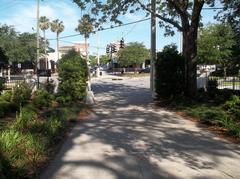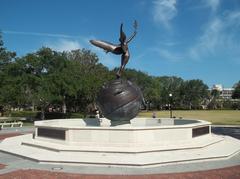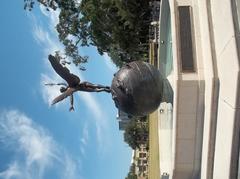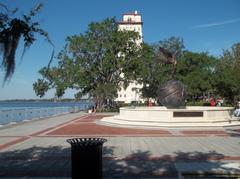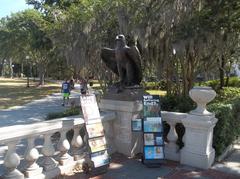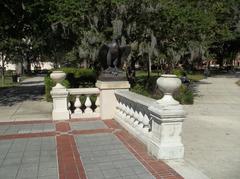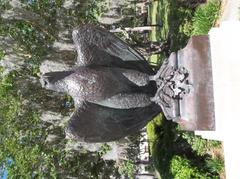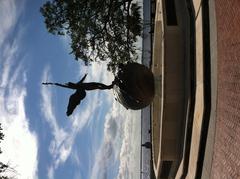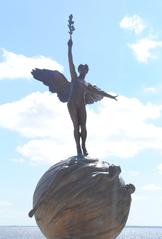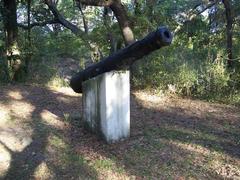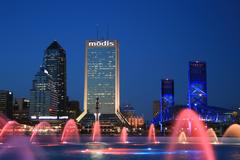
Comprehensive Guide to Visiting Memorial Park, Jacksonville, United States
Date: 18/07/2024
Introduction
Memorial Park in Jacksonville, Florida, stands as a testament to the city’s rich historical and cultural heritage. Established in the early 20th century, this iconic park was conceived as a tribute to the local soldiers who perished during World War I. The project was spearheaded by the Jacksonville Rotary Club in 1919, with the land generously donated by the city and the design entrusted to the illustrious Olmsted Brothers, renowned for their work on Central Park in New York City (Olmsted Brothers). The park was officially dedicated on Christmas Day in 1924, featuring the central bronze sculpture ‘Life,’ created by the famous sculptor Charles Adrian Pillars. This statue, depicting a winged figure reaching towards the sky, symbolizes the spirit of the fallen soldiers ascending to the heavens (Memorial Park Association).
Over the decades, Memorial Park has evolved into more than just a historical landmark. It has become a cultural and social hub, offering a serene environment for reflection, recreation, and community gatherings. The park’s lush landscape, designed by the Olmsted Brothers, includes mature trees, manicured lawns, and scenic views of the St. Johns River, making it a popular destination for locals and tourists alike. The park’s significance extends beyond its historical roots, serving as a vital urban green space that contributes to the city’s ecological health by improving air quality, reducing urban heat island effects, and providing a habitat for various species of birds and wildlife (City of Jacksonville).
Memorial Park has also played a crucial role during significant periods such as the Great Depression and World War II, serving as a community focal point for various events and activities. The park’s management was eventually taken over by the Memorial Park Association, which has been instrumental in maintaining and enhancing the park’s historical and cultural significance through various restoration projects (Memorial Park Association). Today, the park continues to be a cherished public space, hosting numerous events and activities that foster a sense of community and cultural enrichment (Visit Jacksonville).
Table of Contents
- History of Memorial Park
- Recent Renovations and Preservation Efforts
- Visitor Information
- Travel Tips
- Nearby Attractions
- Frequently Asked Questions (FAQ)
- Memorial Park Today
- Stay Up to Date
History of Memorial Park
Early 20th Century Origins
Memorial Park in Jacksonville, Florida, was established in the early 20th century as a tribute to the local soldiers who lost their lives during World War I. The park was conceived in 1919, shortly after the end of the war, by the Jacksonville Rotary Club. The club aimed to create a space that would serve both as a memorial and a public recreational area. The land for the park was donated by the city, and the design was entrusted to the renowned Olmsted Brothers, a prominent landscape architecture firm known for their work on Central Park in New York City (Olmsted Brothers).
Design and Dedication
The design of Memorial Park was completed in 1924, and the park was officially dedicated on Christmas Day of that year. The central feature of the park is the bronze sculpture “Life,” created by the famous sculptor Charles Adrian Pillars. The statue depicts a winged figure reaching towards the sky, symbolizing the spirit of the fallen soldiers ascending to the heavens. The dedication ceremony was a significant event, attended by thousands of Jacksonville residents, including city officials and veterans (Memorial Park Association).
The Great Depression and World War II
During the Great Depression, Memorial Park served as a vital community space where residents could find solace and engage in recreational activities. The park’s maintenance and development were supported by various New Deal programs, which provided employment opportunities for local workers. The Works Progress Administration (WPA) played a crucial role in enhancing the park’s infrastructure, including the construction of pathways and the planting of additional trees and shrubs (WPA Projects).
With the onset of World War II, Memorial Park once again became a focal point for the community. The park hosted numerous events to support the war effort, including bond drives, military parades, and memorial services for soldiers who perished in the conflict. The park’s significance as a memorial was reinforced, and it continued to serve as a place of reflection and remembrance for the residents of Jacksonville.
Post-War Developments
In the post-war years, Memorial Park underwent several renovations and improvements to accommodate the growing population of Jacksonville. The park’s landscape was meticulously maintained, and new amenities were added, such as benches, picnic areas, and playgrounds. The park also became a popular venue for cultural and social events, including concerts, art shows, and community gatherings.
In the 1960s, the park’s management was transferred to the newly formed Memorial Park Association, a non-profit organization dedicated to preserving and enhancing the park’s historical and cultural significance. The association has been instrumental in securing funding for various restoration projects, including the refurbishment of the “Life” statue and the installation of new lighting and irrigation systems (Memorial Park Association).
Recent Renovations and Preservation Efforts
In recent years, Memorial Park has undergone significant renovations to ensure its preservation for future generations. In 2017, the park was severely damaged by Hurricane Irma, which caused extensive flooding and uprooted several trees. The Memorial Park Association launched a major restoration campaign, raising over $1 million to repair the damage and restore the park to its former glory. The restoration efforts included the replanting of trees, the repair of pathways, and the installation of new drainage systems to prevent future flooding (Hurricane Irma Restoration).
In addition to the physical restoration, the association has also focused on enhancing the park’s historical and educational value. In 2019, a series of interpretive panels were installed throughout the park, providing visitors with information about the park’s history, the significance of the “Life” statue, and the contributions of Jacksonville’s soldiers during World War I. These panels serve as a valuable educational resource, helping to deepen visitors’ understanding and appreciation of the park’s historical significance (Interpretive Panels).
Visitor Information
Visiting Hours
Memorial Park is open daily from 6:00 AM to 10:00 PM, providing ample time for visitors to explore and enjoy the park’s serene environment.
Ticket Prices
Entrance to Memorial Park is free, making it an accessible destination for everyone.
How to Get There
Memorial Park is located at 1620 Riverside Avenue, Jacksonville, FL 32204. It is easily accessible by car, and there are several public transportation options available, including bus routes that stop near the park.
Best Times to Visit
The best times to visit Memorial Park are during the spring and fall when the weather is pleasant, and the park’s natural beauty is in full bloom. Early mornings and late afternoons are ideal for a peaceful visit.
Travel Tips
- Parking: There is ample street parking available around the park.
- Accessibility: The park is wheelchair accessible, with paved pathways and ramps.
- Amenities: The park offers benches, picnic areas, and restrooms for visitors’ convenience.
- Photography: The park’s picturesque landscape and the “Life” statue provide excellent photo opportunities.
Nearby Attractions
While visiting Memorial Park, consider exploring other nearby attractions in Jacksonville, such as:
- Cummer Museum of Art and Gardens: Located just a short walk from the park, the museum features an impressive art collection and beautiful gardens (Cummer Museum).
- Riverside Arts Market: Held every Saturday, this vibrant market offers local produce, crafts, and live entertainment (Riverside Arts Market).
- Five Points: A historic district known for its eclectic mix of shops, restaurants, and entertainment options.
Frequently Asked Questions (FAQ)
What are the visiting hours for Memorial Park in Jacksonville? Memorial Park is open daily from 6:00 AM to 10:00 PM.
Is there an entry fee for Memorial Park? No, entrance to Memorial Park is free.
Are there guided tours available? While Memorial Park does not offer regular guided tours, the interpretive panels throughout the park provide valuable information about its history.
Can I host events at Memorial Park? Yes, Memorial Park is available for hosting events such as weddings, picnics, and community gatherings. Contact the Memorial Park Association for more details.
Memorial Park Today
Today, Memorial Park remains one of Jacksonville’s most cherished public spaces. It continues to serve as a place of remembrance, reflection, and recreation for residents and visitors alike. The park’s lush landscape, scenic views of the St. Johns River, and historical significance make it a popular destination for picnics, walks, and community events. The Memorial Park Association continues to play a vital role in maintaining and enhancing the park, ensuring that it remains a fitting tribute to the soldiers who made the ultimate sacrifice for their country (Memorial Park Association).
Memorial Park’s enduring legacy is a testament to the community’s commitment to honoring its history and preserving its cultural heritage. As Jacksonville continues to grow and evolve, the park stands as a symbol of the city’s resilience, unity, and respect for those who have served and sacrificed.
Stay Up to Date
For more information and updates about Memorial Park, download the Memorial Park mobile app, visit the official website, or follow the Memorial Park Association on social media.
Conclusion
Memorial Park in Jacksonville is more than just a park; it is a living monument that honors the past while serving the present and future generations. Its rich history, marked by its dedication as a tribute to World War I soldiers, and its beautiful design by the Olmsted Brothers make it a significant historical landmark. The park’s central feature, the ‘Life’ statue by Charles Adrian Pillars, stands as a poignant reminder of the sacrifices made by the soldiers and the resilience of the human spirit (Memorial Park Association).
Over the years, Memorial Park has evolved into a vital cultural and social hub for the Jacksonville community. It offers a serene environment for reflection and recreation, with amenities such as walking paths, picnic areas, and scenic views of the St. Johns River. The park’s role during the Great Depression and World War II further underscores its importance as a community gathering space (WPA Projects).
Recent preservation efforts, particularly after the damage caused by Hurricane Irma, demonstrate the community’s commitment to maintaining and enhancing this cherished public space. The installation of interpretive panels and other educational resources has also added to the park’s value as a historical and educational site (Hurricane Irma Restoration).
Today, Memorial Park continues to be a beloved destination for both residents and visitors. Its lush landscape, historical significance, and role as a community hub make it a vital part of Jacksonville’s heritage. Whether you’re looking to explore its historical roots, enjoy a peaceful day outdoors, or participate in community events, Memorial Park offers a meaningful and enriching experience. The park’s enduring legacy is a testament to the community’s dedication to honoring its history and preserving its cultural heritage (Memorial Park Association).
References
- Memorial Park Association. (n.d.). History of Memorial Park. Retrieved from https://memparkjax.org/history/
- Olmsted Brothers. (n.d.). The Olmsted Legacy. Retrieved from https://www.olmsted.org/the-olmsted-legacy/the-olmsted-firm
- WPA Projects. (n.d.). New Deal Programs. Retrieved from https://www.archives.gov/research/new-deal
- City of Jacksonville. (n.d.). Official Website. Retrieved from https://www.coj.net/
- Visit Jacksonville. (n.d.). Official Website. Retrieved from https://www.visitjacksonville.com/
- Jacksonville.com. (2017, September 12). Memorial Park Recovery Effort Gets Boost from Donors. Retrieved from https://www.jacksonville.com/news/20170912/memorial-park-recovery-effort-gets-boost-from-donors
